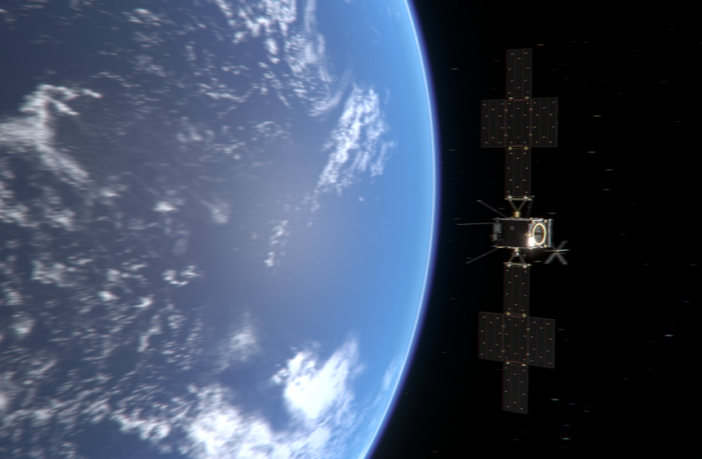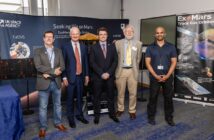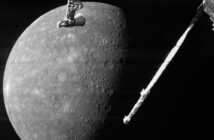Space researchers from the Open University Atmospheric Research and Surface Exploration group, led by Prof. Manish Patel, and the Centre for Electronic Imaging, watched in trepidation as the Jupiter and Icy Moons Explorer (JUICE) spacecraft flew back past the Moon and the Earth on its long voyage to Jupiter. In a world-first space manoeuvre, JUICE did a combined flyby of both the Moon and the Earth in close succession.
JUICE carries the JANUS camera, which uses UK-built Teledyne e2v detectors provided by the Open University. The instrument is led by Prof. Pasquale Palumbo in Italy, with an international consortium including Germany, Spain and the UK. JANUS is a high-resolution camera, designed to operate and survive in the intensely harsh radiation environment of Jupiter, and will study the atmosphere of Jupiter and the surfaces of its icy moons when it arrives at Jupiter in 2031.
The Moon encounter took place at 22:15 UK time on 19 August, guiding JUICE towards Earth at 22:56 on 20 August. JUICE flew at an altitude of 6,840 km above south-east Asia and the Pacific Ocean; for both the Moon and Earth encounters, the JANUS camera was turned on and a series of test images were taken as it flew past.
Threading the Earth-Moon needle
JANUS returned a series of images showing its bird’s-eye view over the Moon and Earth, showing in spectacular detail the cratered surface of the Moon, and night-time images of clouds over the Pacific Ocean. The images shown below are only partially calibrated.

(left) Overflight images of the Moon; (centre) the Earth horizon; (right) clouds over the Pacific Ocean.
Prof. Patel, who is the UK-lead for the JANUS instrument, said:
’This has been a long and nervous time for us, preparing and waiting for the outcome of such a complex set of space manoeuvres. What we see here, in these images, is the hard work, dedication and commitment of the spaceflight team here at the OU.
The detectors, the ‘eyes’ of the JANUS instrument that we provided from the OU, are already generating exciting images – and this is only a tiny taste of the scientific splendour that awaits us at Jupiter in several years time.’
Now, voyager, sail thou forth
JUICE is now heading into deep space, on its way to Jupiter. Often, slingshots are perceived as only speeding up spacecraft. In this case, JUICE is doing the opposite – going slower, to end up going faster and further.
The encounter with the Moon and Earth in fact slowed down JUICE, so that it falls into the inner solar system to take a cosmic shortcut. There it will encounter Venus, which will fling it back out towards Earth for another flyby, providing the speed necessary to get all the way out to Jupiter by 2031.
Dr. Chiaki Crews, from the Centre for Electronic Imaging and worked on the JANUS detectors, commented:
‘It is lovely to see images being returned from space from the detector that we provided to this instrument. Seeing the camera work so well in-flight makes all the hard work we put in over several years worth it. These fly-by images also provide an excellent opportunity to run critical checks to help improve processes for the eventual mission at Jupiter’s icy moons.’
The OU team working on this project includes Prof. Manish Patel, Dr. Chiaki Crews, Dr. Konstantin Stefanov, Martyna Hodges, Dr. Jon Mason, Dr. Mark Leese and Prof. Matt Balme.



